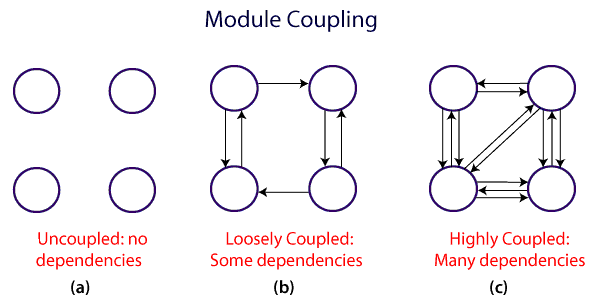When a software program is modularized, its tasks are divided into several modules based on some characteristics. As we know, modules are set of instructions put together in order to achieve some tasks. They are though, considered as single entity but may refer to each other to work together. There are measures by which the quality of a design of modules and their interaction among them can be measured. These measures are called coupling and cohesion.
Cohesion
Cohesion is a measure that defines the degree of intra-dependability within elements of a module. The greater the cohesion, the better is the program design.
There are seven types of cohesion, namely –
● Co-incidental cohesion – It is unplanned and random cohesion, which might be the result of breaking the program into smaller modules for the sake of modularization. Because it is unplanned, it may serve confusion to the programmers and is generally not-accepted.
● Logical cohesion – When logically categorized elements are put together into a module, it is called logical cohesion.
● Temporal Cohesion – When elements of module are organized such that they are processed at a similar point in time, it is called temporal cohesion.
● Procedural cohesion – When elements of module are grouped together, which are executed sequentially in order to perform a task, it is called procedural cohesion.
● Communicational cohesion – When elements of module are grouped together, which are executed sequentially and work on same data (information), it is called communicational cohesion.
● Sequential cohesion – When elements of module are grouped because the output of one element serves as input to another and so on, it is called sequential cohesion.
● Functional cohesion – It is considered to be the highest degree of cohesion, and it is highly expected. Elements of module in functional cohesion are grouped because they all contribute to a single well-defined function. It can also be reused.
Coupling
Coupling is a measure that defines the level of inter-dependability among modules of a program. It tells at what level the modules interfere and interact with each other. The lower the coupling, the better the program.
There are five levels of coupling, namely –
● Content coupling – When a module can directly access or modify or refer to the content of another module, it is called content level coupling.
● Common coupling- When multiple modules have read and write access to some global data, it is called common or global coupling.
● Control coupling- Two modules are called control-coupled if one of them decides the function of the other module or changes its flow of execution.
● Stamp coupling- When multiple modules share common data structure and work on different part of it, it is called stamp coupling.
● Data coupling- Data coupling is when two modules interact with each other by means of passing data (as parameter). If a module passes data structure as parameter, then the receiving module should use all its components.
Ideally, no coupling is considered to be the best.


